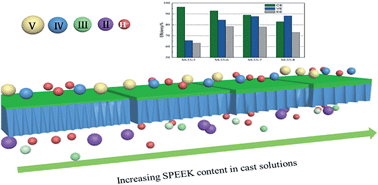Morphology and performance of poly(ether sulfone)/sulfonated poly(ether ether ketone) blend porous membranes for vanadium flow battery application
Abstract
Poly(ether sulfone) (PES) porous membranes with tunable morphology were fabricated via a phase inversion method and applied in vanadium flow batteries (VFBs). The morphology of the PES membrane was adjusted by changing the polymer concentration and blending with hydrophilic sulfonated poly(ether ether ketone) (SPEEK) in the cast solution. The relationship between the membrane morphology and the performance in VFBs was investigated in detail. The results indicated that with increasing polymer concentration of the cast solution, the number of macrovoids gradually decreased and the finger-like pores became larger. A higher coulombic efficiency (CE) can be obtained due to the lower vanadium permeability, while the voltage efficiency (VE) decreased. In addition, the introduction of SPEEK in cast solution will induce the transformation of membrane structures from finger-like to spongy-like pores. The CE decreased with the higher vanadium permeability, while the VE increased due to the increased proton conductivity. As a result, optimized VFB performance of the PES membranes was obtained, showing a CE of 92.8% and an energy efficiency (EE) of 78.4%. The battery assembled with the prepared membranes showed a stable battery performance after running for more than 200 cycles, showing good oxidation stability. This work presents an effective and facile method to fabricate PES membranes with tunable battery performance.

- This article is part of the themed collection: Materials for Energy storage

 Please wait while we load your content...
Please wait while we load your content...